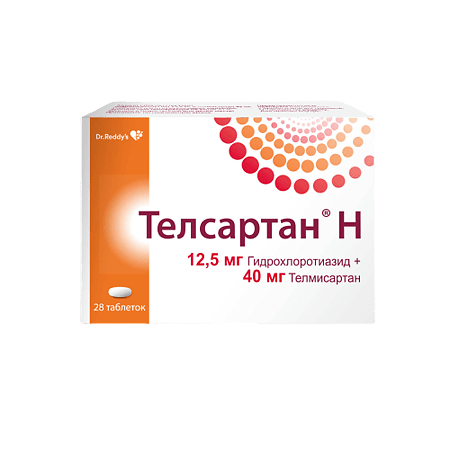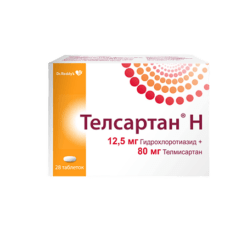No products in the cart.
Telsartan N, tablets 12.5mg+40 mg pcs
€13.47 €11.79
Description
Pharmacodynamics
Telsartan® N is a combination of telmisartan (angiotensin II receptor antagonist) and hydrochlorothiazide – thiazide diuretic. Simultaneous use of these components leads to a greater antihypertensive effect than the use of each of them separately. Administration of Telsartan® H once daily leads to a significant gradual decrease in blood pressure (BP).
Telmisartan
Telmisartan is a specific angiotensin receptor antagonist (ARA) II, effective when taken orally. It has a high affinity for the AT1 subtype of angiotensin II receptors, through which the action of angiotensin II is realized.
It displaces angiotensin II from binding to the receptor without exhibiting agonist properties against this receptor. Telmisartan binds only to the AT1 subtype of the angiotensin II receptor. The binding is long-lasting. It has no affinity for other receptors, including AT2 receptor and other less studied angiotensin receptors.
The functional significance of these receptors as well as the effect of their possible overstimulation by angiotensin II, the concentration of which increases with telmisartan administration, has not been studied. Telmisartan reduces plasma aldosterone concentration, does not inhibit plasma renin and does not block ion channels. Telmisartan does not inhibit angiotensin-converting enzyme (kininase II), which also catalyzes bradykinin degradation. Therefore, an increase in bradykinin-induced side effects is not expected.
In patients with arterial hypertension, telmisartan at a dose of 80 mg completely blocks the hypertensive effects of angiotensin II. Initiation of antihypertensive action is observed within 3 hours after the first oral administration of telmisartan. The action of the drug persists for 24 hours and remains significant up to 48 hours. Apparent antihypertensive effect usually develops 4 weeks after regular drug intake.
In patients with arterial hypertension telmisartan reduces systolic and diastolic BP without affecting heart rate (HR).
In the case of abrupt telmisartan withdrawal, BP gradually returns to baseline levels without the development of “withdrawal” syndrome.
The study with telmisartan evaluated cardiovascular mortality, nonfatal myocardial infarction, nonfatal stroke or hospitalization due to chronic heart failure.
It has been shown to reduce cardiovascular morbidity and mortality in patients at high cardiovascular risk (with coronary artery disease, stroke, peripheral artery disease or diabetes with concomitant target organ damage such as retinopathy, left ventricular hypertrophy, macro- or microalbuminuria in the history) over 55 years of age.
Hydrochlorothiazide
Hydrochlorothiazide is a thiazide diuretic. Thiazide diuretics affect electrolyte reabsorption in the renal tubules by directly increasing sodium and chloride excretion (approximately equivalent amounts).
Diuretic effect of hydrochlorothiazide leads to a decrease in circulating blood volume (RBC), increased plasma renin activity, increased secretion of aldosterone with a subsequent increase in urinary potassium and hydrocarbonates and, consequently, a decrease in plasma potassium.
In concomitant administration with telmisartan there is a tendency to stop potassium loss caused by these diuretics, presumably due to blockade of the renin-angiotensin-aldosterone system (RAAS).
After oral administration diuresis increases after 2 hours, and the maximum effect is observed after about 4 hours. Diuretic effect of the drug lasts for about 6-12 hours.
Long-term use of hydrochlorthiazide reduces the risk of cardiovascular disease complications and mortality from them.
The maximal antihypertensive effect of Telsartan® H is usually achieved 4 weeks after initiation of treatment.
Pharmacokinetics
Indications
Indications
Active ingredient
Active ingredient
Composition
Composition
How to take, the dosage
How to take, the dosage
Interaction
Interaction
Telmisartan
Hypotensive agents
An increase in the antihypertensive effect is possible. One study observed a 2.5-fold increase in AUC0-24 and Cmax of ramipril and ramiprilat when telmisartan and ramipril were combined. The clinical significance of this interaction has not been established.
In an analysis of adverse events leading to discontinuation of treatment and an analysis of serious adverse events from a clinical trial, it was found that cough and angioedema were more frequently seen on ramipril therapy, whereas arterial hypotension was more frequently seen on telmisartan therapy.
Hyperkalemia, renal failure, arterial hypotension, and syncope were significantly more common with telmisartan and ramipril.
Lithium preparations
There have been reversible increases in plasma lithium concentrations accompanied by toxic effects with ACE inhibitors.
In rare cases such changes have been reported with the use of angiotensin II receptor antagonists, particularly telmisartan. When concomitant use of lithium preparations and angiotensin II receptor antagonists, determination of lithium content in blood is recommended.
Non-steroidal anti-inflammatory drugs (NSAIDs)
. NSAIDs, including acetylsalicylic acid in doses used as an anti-inflammatory agent, cyclooxygenase-2 (COX-2) inhibitors and non-selective NSAIDs, may cause acute renal failure in patients with decreased RBC.
The drugs affecting the RAAS may have a synergistic effect. In patients receiving NSAIDs and telmisartan, the BCC should be compensated and renal function should be monitored at the beginning of treatment.
A decreased effect of hypotensive agents such as telmisartan through inhibition of the vasodilatory effect of prostaglandins has been noted when coadministered with NSAIDs. No clinically significant effect has been observed when telmisartan is taken concomitantly with ibuprofen or paracetamol.
Digoxin, warfarin, hydrochlorothiazide, glibenclamide, simvastatin and amlodipine
There were no clinically significant interactions. There was an increase in the average plasma concentration of digoxin by an average of 20% (in one case by 39%). When concomitant use of telmisartan and digoxin, periodic determination of plasma concentrations of digoxin is advisable.
Aliskiren, aliskiren-containing drugs
. Clinical data have shown that dual RAAS blockade, by coadministration with ACE inhibitors, angiotensin II receptor blockers, or aliskiren is associated with a high incidence of side effects such as hypotension, hyperkalemia, and decreased renal function (including acute renal failure) compared with the use of a single active RAAS blocker.
Hydrochlorothiazide
Ethanol, barbiturates or narcotic analgesics
Risk of orthostatic hypotension.
Hypoglycemic oral agents and insulin
The dose of hypoglycemic oral agents and insulin may need to be adjusted.
Metformin
Risk of lactic acidosis.
Colestyramine and colestipol
In the presence of anion exchange resins, the absorption of hydrochlorothiazide is impaired.
Cardiac glycosides
Risk of hypokalemia or hypomagnesemia caused by thiazide diuretics, development of arrhythmias caused by taking cardiac glycosides.
Pressor amines (e.g., norepinephrine)
The effects of pressor amines may be impaired.
Nondepolarizing myorelaxants (e.g., tubocurarine chloride)
Hydrochlorothiazide may increase the effect of nondepolarizing myorelaxants.
Antipodagric agents
The concentration of uric acid in the blood serum may increase, and therefore it may be necessary to change the dose of uricosuric agents. The use of thiazide diuretics increases the incidence of hypersensitivity reactions to allopurinol.
Calcium preparations and vitamin D
Thiazide diuretics may increase serum calcium levels due to reduced renal excretion. If it is necessary to use calcium preparations, serum calcium levels should be monitored regularly, and the dose of calcium preparations should be changed, if necessary.
Beta-adrenoblockers and diazoxide
Tiazide diuretics may increase the hyperglycemia caused by beta-adrenoblockers and diazoxide.
M-cholinoblockers (e.g., atropine, biperiden)
Decrease gastrointestinal motility, increase bioavailability of thiazide diuretics.
Amantadine
The clearance of amantadine may be decreased by hydrochlorothiazide, which leads to increased plasma concentrations of amantadine and possible toxicity.
Cytotoxic agents (e.g., cyclophosphamide, methotrexate)
Decrease renal excretion of cytotoxic agents and increase their myelosuppressive effect.
NSAIDs
Concomitant use with thiazide diuretics may lead to decreased diuretic and antihypertensive effects.
Medications that lead to potassium excretion and hypokalemia
Medications such as potassium excretion diuretics; laxatives; Glucocorticosteroids; calcitonin; adrenocorticotropic hormone (ACTH); glycyrrhizic acid (found in licorice root); amphotericin B; carbenoxolone; benzylpenicillin: Acetylsalicylic acid derivatives) may lead to increased hypokalemic effects. Hypokalemia caused by hydrochlorothiazide is compensated by the potassium-saving effect of telmisartan.
Theophylline
An increased risk of hypokalemia.
Amiodarone
Simultaneous use with thiazide diuretics may lead to an increased risk of arrhythmias associated with hypokalemia.
Potassium-saving diuretics, potassium preparations, other agents that can increase serum potassium levels (e.g., heparin)
These agents, as well as replacement of sodium in table salt with potassium salts, can lead to hyperkalemia.
Periodic monitoring of plasma potassium is recommended during concomitant use of Telsartan® N with drugs that may cause hypokalemia as well as with drugs that may increase serum potassium.
Special Instructions
Special Instructions
Synopsis
Synopsis
Contraindications
Contraindications
Side effects
Side effects
Overdose
Overdose
No cases of overdose have been identified.
Possible symptoms of overdose consist of symptoms from the individual components of the drug.
Telmisartan – marked BP decrease, tachycardia, bradycardia.
Hydrochlorothiazide – disorders of water-electrolyte balance of the blood (hypokalemia, hypochloremia), reduction of the blood circulation, which may lead to muscle spasms and/or exacerbate cardiovascular disorders: arrhythmias caused by simultaneous use of cardiac glycosides or some antiarrhythmic drugs.
Treatment: symptomatic therapy, hemodialysis is ineffective. The degree of hydrochlorothiazide removal during hemodialysis has not been established. Regular monitoring of electrolytes and serum creatinine concentration is necessary.
Pregnancy use
Pregnancy use
Similarities
Similarities
Additional information
| Shelf life | 1 year |
|---|---|
| Conditions of storage | Temperature not exceeding 25°C. Store out of the reach of children! |
| Manufacturer | Dr. Reddy's, India |
| Medication form | pills |
| Brand | Dr. Reddy's |
Other forms…
Related products
Buy Telsartan N, tablets 12.5mg+40 mg pcs with delivery to USA, UK, Europe and over 120 other countries.















